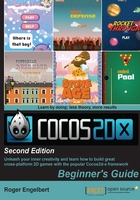
上QQ阅读APP看书,第一时间看更新
Time for action – implementing init()
Inside init(), we'll build the game screen, bringing in all the sprites and labels we'll need for the game:
- So right after the
ifstatement where we call the superLayer::initmethod, we add:_players = Vector<GameSprite*>(2); _player1Score = 0; _player2Score = 0; _screenSize = Director::getInstance()->getWinSize();
- We create the vector where we'll store both players, initialize the score values, and grab the screen size from the singleton, all-knowing
Director. We'll use the screen size to position all sprites relatively. Next we will create our first sprite. It is created with an image filename, whichFileUtilswill take care of loading from the correct folder:auto court = Sprite::create("court.png"); court->setPosition(Vec2(_screenSize.width * 0.5, _screenSize.height * 0.5)); this->addChild(court); - Get into the habit of positioning sprites with relative values, and not absolute ones, so we can support more screen sizes. And say hello to the
Vec2type definition used to create points; you'll be seeing it a lot in Cocos2d-x. - We finish by adding the sprite as a child to our
GameLayer(the court sprite does not need to be aGameSprite). - Next we will use our spanking new
GameSpriteclass, carefully positioning the objects on screen:_player1 = GameSprite::gameSpriteWithFile("mallet.png"); _player1->setPosition(Vec2(_screenSize.width * 0.5, _player1->radius() * 2)); _players.pushBack(_player1); this->addChild(_player1); _player2 = GameSprite::gameSpriteWithFile("mallet.png"); _player2->setPosition(Vec2(_screenSize.width * 0.5, _screenSize.height - _player1->radius() * 2)); _players.pushBack(_player2); this->addChild(_player2); _ball = GameSprite::gameSpriteWithFile("puck.png"); _ball->setPosition(Vec2(_screenSize.width * 0.5, _screenSize.height * 0.5 - 2 * _ball->radius())); this->addChild(_ball); - We will create TTF labels with the
LabelclasscreateWithTTFstatic method, passing as parameters the initial string value (0), and the path to the font file. We will then position and rotate the labels:_player1ScoreLabel = Label::createWithTTF("0", "fonts/Arial.ttf", 60); _player1ScoreLabel->setPosition(Vec2(_screenSize.width - 60, _screenSize.height * 0.5 - 80)); _player1ScoreLabel->setRotation(90); this->addChild(_player1ScoreLabel); _player2ScoreLabel = Label::createWithTTF("0", "fonts/Arial.ttf", 60); _player2ScoreLabel->setPosition(Vec2(_screenSize.width - 60, _screenSize.height * 0.5 + 80)); _player2ScoreLabel->setRotation(90); this->addChild(_player2ScoreLabel); - Then we turn
GameLayerinto a multitouch event listener and tell theDirectorevent dispatcher thatGameLayerwishes to listen to those events. And we finish by scheduling the game's main loop as follows:auto listener = EventListenerTouchAllAtOnce::create(); listener->onTouchesBegan = CC_CALLBACK_2(GameLayer::onTouchesBegan, this); listener->onTouchesMoved = CC_CALLBACK_2(GameLayer::onTouchesMoved, this); listener->onTouchesEnded = CC_CALLBACK_2(GameLayer::onTouchesEnded, this); _eventDispatcher->addEventListenerWithSceneGraphPriority(listener, this); //create main loop this->scheduleUpdate(); return true;
